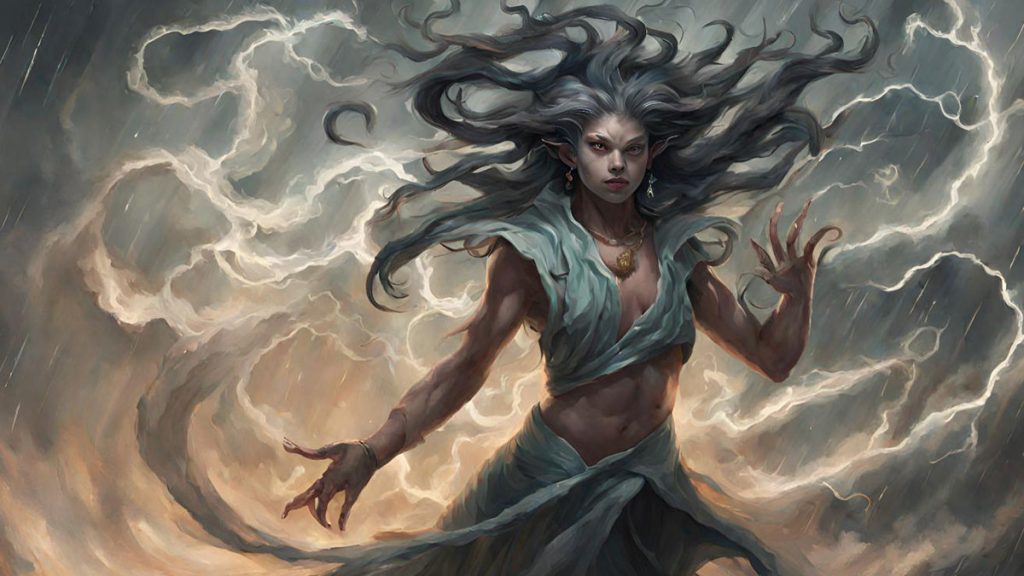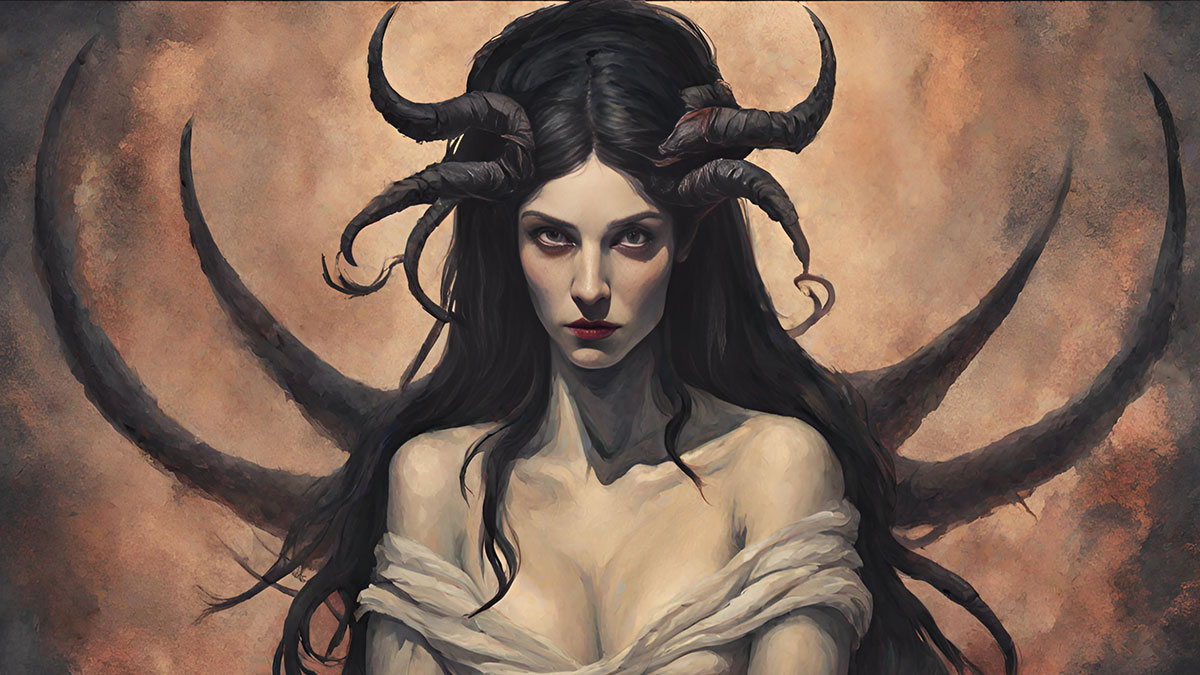Lilith is a powerful female demon prevalent within medieval Jewish literature but has deep roots going back thousands of years in ancient Mesopotamian and Babylonian religions. She later became a feminist icon in the late 20th century.
Throughout the centuries of her existence, Liith has been chiefly associated with a demonic force that specifically attacks pregnant women and unborn or newly born babies. She can also latch onto an unwitting and unwilling man, harvesting his semen to create demons. Over time, Lilith has been blamed for all problems relating to high mortality rates from childbirth, to abortion, to infidelity and marriage breakdown.
Lilith-like female demon creatures have featured across the Middle East and in multiple cultures beyond and are included in Sumerian, Babylonian, Assyrian, Canaanite, Persian, Hebrew, Arabic, and Teutonic mythologies. She was known by worshipers of many religions, including Jewish, Islamic, Mandaean, Christian, and pagan communities. Lilith can be traced back 4000 years to the Sumerian and Babylonian civilizations, where she was named Lilitu, a storm or wind demon that bore male creatures called lilû-demons and their female equivalent, lilî-demons.

These demons were jealous, vengeful creatures that entered people’s homes, attacking pregnant women and young babies. They were sexually frustrated and aggressive toward young men and women. The breasts of the female demons contained poison instead of milk.
Lilith in Sumerian and Babylonian civilizations
The earliest known mention of Lilith comes from a 4000-year-old epic Sumerian poem about the adventures of the Mesopotamian King, Gilgamesh, where the hero of the story banishes Lilith to the desert. Likely, Lilith was already a well-established presence in popular belief before this poem appeared; the audience would have been expected to know about Lilith.
The first known image of Lilith appears in the Burney Relief, a Mesopotamian terracotta plaque from the same time period as the Gilgamesh poem. The plaque features a naked, long-haired female spirit with wings and talons for feet. She is standing on two lions and between two owls that she appears to control.
Lilith’s image has been found on numerous plaques, tablets, and pottery from the following thousands of years. Her image on plaques is usually accompanied by an incantation that attempts to keep Lithith out. A plaque found in Syria in 1933, dated to the 7th or 8th century BC, is thought to have been hung by the door of a pregnant woman and seems to ward off Lilith. One translation reads: “O you who fly in [the] darkened room[s], / Be off with you this instant, this instant, Lilith. / Thief, breaker of bones.”
Lilith became the first wife of Adam in Judaism
Lilith became prominent within Jewish literature in the early medieval period after she appeared in the Babylonian Talmud. The Talmud is a set of rabbinic religious teachings and laws laid out in the early Middle Ages to help Jewish people in their day-to-day lives. In one section, Lilith is mentioned as a succubus-type figure who preys on men who sleep alone. The book suggests that men never sleep in a house alone.
In later Jewish texts, such as the Alphabet of Ben Sira, written sometime between 700 and 1000 AD, it emerges that Lilith had been Adam’s first wife before Eve. The first chapter of Genesis explains that Adam was created from the soil and a woman was made in his image; the following chapter states that Eve was then created from Adam’s rib. Later Jewish literature suggested that the woman from chapter one was actually Lilith. According to the literature, Lilith refused to lie under Adam during sexual intercourse, claiming that she was his equal, so they should both lie on their sides.

Lilith left the Garden of Eden (or was thrown out) and refused to return. Three angels were sent to persuade Lilith to return to Adam, but she refused to accept that she was not Adam’s equal and would not return. At this point, Lilith said her purpose was to make human babies sick. The angels told Lilith she could not touch any child who wore an amulet with her name or form. This tale led to many children and babies wearing amulets, beads, and other talismans to ward off Lilith and her demons. A practice that continued amongst people of numerous faiths into the modern age.
Lilith also made an appearance in the Dead Sea Scrolls. The Scrolls, thought to date as far back as the 3rd Century BC, contain a reference to Lilith within a hymn possibly used in exorcisms. According to academic Janet Howe Gaines, the Jewish community at Qumran, where the Scrolls were recovered, would have been well-versed in demonology.
The relevant section in the Scrolls reads:
“And I, the Sage, sound the majesty of His beauty to terrify and confound all the spirits of destroying angels and the bastard spirits, the demons, Lilith. . ., and those that strike suddenly, to lead astray the spirit of understanding, and to make desolate their heart.”
Lilith within Islam and Christianity
Within the Islamic community, the story of Lilith merged into the Qarinah, a demon woman who was spurned by Adam and turned her hatred onto all humans. The Qarinah murdered unborn and born babies and made men impotent. Some within the Islamic tradition saw the Qarinah/Lilith as the mother of all Jinn/demons. Similarly to Jews, Muslims would wear amulets and beads and use incantation bowls to ward off the demon child killer.
In the Christian Bible, Lilith is mentioned only once and only in certain versions. She appears in Isaiah 34:14 and is referred to as a night monster or night creature who inhabits wastelands. However, the most common versions of the Christian Bible, including the King James (KJV) and New International versions, do not mention Lilith by name. The KJV does refer to a “screech owl,” which may be seen as a substitute for a “night creature.”
In the Renaissance, Lilith appeared on the Sistine Chapel in Michaelangelo’s The Fall of Man, where she was represented as a half-woman, half-serpent, wrapped around the Tree of Knowledge. She has also appeared in Western literature, including in works by English poet Dante Gabriel Rossetti and Irish novelist James Joyce.
Lilith as a femisnist icon
In the 1970s, Lilith was adopted as a feminist icon, particularly by Jewish feminists, who created a magazine named after her. According to Rebecca Lesses, Lilith traditionally embodied people’s fears about the dangers of infidelity and sexual promiscuity and also the hazards of childbirth.
However, in 1972, feminist Lilly Rivlin argued that Lilith actually embodied women’s independence. Rivlin and other feminists portrayed her as a strong, powerful woman who stood up to Adam and God and followed her own path.
References
FairytalesAnd Myths.com, “Qarinah,” accessed April 12, 2024.
Gaines, Janet Howe. “Lilith Seductress, heroine or murderer?” in Biblical Archaeology Society, accessed April 11, 2024.
Koltuv, Barbara Black. “The Book of Lilith,” (1986), Pub.: Nicolas-Hays, Incorporated, accessed April 12, 2024.
Lesses, Rebecca. “Lilith,” in Jewish Women’s Archive, accessed April 11, 2024.
Lebling, Robert. “Legends of the Fire Spirits,” (2010), I.B. Tauris, accessed April 12, 2024.
